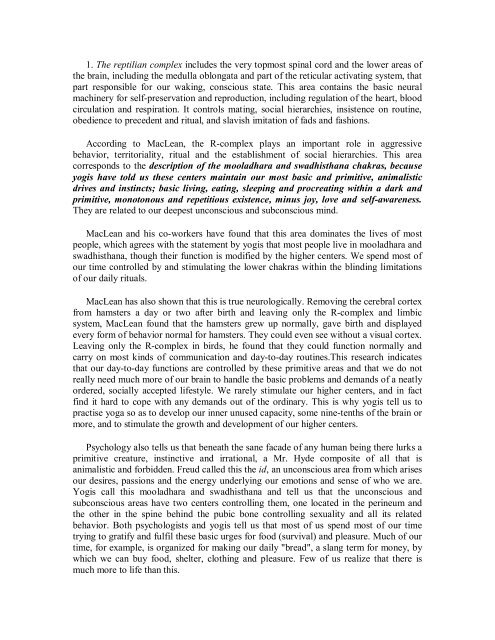Kundalini.Tantra.by.Satyananda.Saraswati
You also want an ePaper? Increase the reach of your titles
YUMPU automatically turns print PDFs into web optimized ePapers that Google loves.
1. The reptilian complex includes the very topmost spinal cord and the lower areas of<br />
the brain, including the medulla oblongata and part of the reticular activating system, that<br />
part responsible for our waking, conscious state. This area contains the basic neural<br />
machinery for self-preservation and reproduction, including regulation of the heart, blood<br />
circulation and respiration. It controls mating, social hierarchies, insistence on routine,<br />
obedience to precedent and ritual, and slavish imitation of fads and fashions.<br />
According to MacLean, the R-complex plays an important role in aggressive<br />
behavior, territoriality, ritual and the establishment of social hierarchies. This area<br />
corresponds to the description of the mooladhara and swadhisthana chakras, because<br />
yogis have told us these centers maintain our most basic and primitive, animalistic<br />
drives and instincts; basic living, eating, sleeping and procreating within a dark and<br />
primitive, monotonous and repetitious existence, minus joy, love and self-awareness.<br />
They are related to our deepest unconscious and subconscious mind.<br />
MacLean and his co-workers have found that this area dominates the lives of most<br />
people, which agrees with the statement <strong>by</strong> yogis that most people live in mooladhara and<br />
swadhisthana, though their function is modified <strong>by</strong> the higher centers. We spend most of<br />
our time controlled <strong>by</strong> and stimulating the lower chakras within the blinding limitations<br />
of our daily rituals.<br />
MacLean has also shown that this is true neurologically. Removing the cerebral cortex<br />
from hamsters a day or two after birth and leaving only the R-complex and limbic<br />
system, MacLean found that the hamsters grew up normally, gave birth and displayed<br />
every form of behavior normal for hamsters. They could even see without a visual cortex.<br />
Leaving only the R-complex in birds, he found that they could function normally and<br />
carry on most kinds of communication and day-to-day routines.This research indicates<br />
that our day-to-day functions are controlled <strong>by</strong> these primitive areas and that we do not<br />
really need much more of our brain to handle the basic problems and demands of a neatly<br />
ordered, socially accepted lifestyle. We rarely stimulate our higher centers, and in fact<br />
find it hard to cope with any demands out of the ordinary. This is why yogis tell us to<br />
practise yoga so as to develop our inner unused capacity, some nine-tenths of the brain or<br />
more, and to stimulate the growth and development of our higher centers.<br />
Psychology also tells us that beneath the sane facade of any human being there lurks a<br />
primitive creature, instinctive and irrational, a Mr. Hyde composite of all that is<br />
animalistic and forbidden. Freud called this the id, an unconscious area from which arises<br />
our desires, passions and the energy underlying our emotions and sense of who we are.<br />
Yogis call this mooladhara and swadhisthana and tell us that the unconscious and<br />
subconscious areas have two centers controlling them, one located in the perineum and<br />
the other in the spine behind the pubic bone controlling sexuality and all its related<br />
behavior. Both psychologists and yogis tell us that most of us spend most of our time<br />
trying to gratify and fulfil these basic urges for food (survival) and pleasure. Much of our<br />
time, for example, is organized for making our daily "bread", a slang term for money, <strong>by</strong><br />
which we can buy food, shelter, clothing and pleasure. Few of us realize that there is<br />
much more to life than this.














![[Lonely Planet] Sri Lanka](https://img.yumpu.com/59845622/1/169x260/lonely-planet-sri-lanka.jpg?quality=85)


